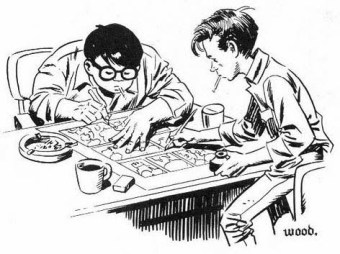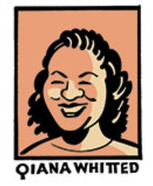|
Originally posted at Pencil Panel Page. This year’s International Comic Arts Forum will include a roundtable discussion on collaboration in comics that considers the way academics and industry professionals approach the dialogic qualities of creation in the industry (look for a panel of original papers addressing this topic at MLA 2014 as well). The discussion grows out of a concern that comics scholars too often privilege the authorship of a lone gifted writer, potentially “ignoring the historical importance and artistic potential of multi-authored comics.” So I thought I would bring the question to PPP readers as well. Why don’t we give the collaborative aspects of comics more serious attention? What are the risks and/or advantages that come from talking about these texts as a medley of complementary, diverging, or competing interests rather than a single creative vision? The issue has become especially important to my own research over the last few years. When I initially ventured into comics studies as a literary critic, I often found myself attributing primary “ownership” of the narrative to the writer with the penciller, inker, colorist, letterer and editorial staff receiving only a mention. Much of the academic comics scholarship that I encountered reinforced this view, as do the prestigious awards and “best of” lists that often champion the single artist/writer. (No wonder Eddie Campbell is under the misconception that “the literaries” ignore the narrative drawings in comics and consider only the plot.) In my work on the 1980s Swamp Thing run, however, I found that this approach did not suit me well and I tried to do my best to be more attentive to the role of collaboration between Alan Moore, Stephen Bissette, and John Totleben in the finished product. Now in my current research, I am particularly fascinated by the way EC’s comics were developed during the 1950s. It was a frantic, nearly assembly-line construction that nevertheless strived to maintain the individuality of the creative professionals. Bill Gaines and Al Feldstein often described how they worked with a team of freelancers to produce four stories a week, churning out springboards and lettered pages for illustration. In an interview for The Monster Times in 1972, Gaines and Feldstein commented upon the process:
Al: Now this was something that hadn’t been done too much in the comics either. There was imitation of styles. And books were sterile and really had no character. We encouraged each artist to develop his own style, actually wrote and tailored the stories based on the artist’s ability and style. Graham always did the Old Witch and the kind of gothicy stuff. And a finished neat artist like Jack Kamen did the modern, triangle stories with a husband and wife living in the suburbs behind a picket fence, because his style lent himself to that. Bill: I thought it was more than that. When we sat down to write a story, we were writing the story for a particular artist. So one day we sat down to write a story I would say to Al: “Today we have a seven page story for Graham Ingels to write.” We would think in that direction… Regardless of how we might feel about EC taking credit for starting this particular editorial trend, their comics certainly demonstrate a dynamic range of collaborative efforts. A quick glance at the title page and signature of any EC story would give regular readers stylistic clues about what the narrative had in store. (Indeed, when it comes to EC, it’s the writers – not the artists – who often play second fiddle. Readers forget that the stories were almost all completely written or adapted by Gaines, Feldstein or Kurtzman. Even recent reprints from IDW andFantagraphics reinforce a view that continues to privilege the single artist as creator.) So how do you approach collaboration in comics? What other questions about collaboration should I bring to the panel? Comments are closed.
|
AboutAn archive of my online writing on comics, literature, and culture. (Illustration above by Seth!) Categories
All
Archives
July 2020
|


 RSS Feed
RSS Feed